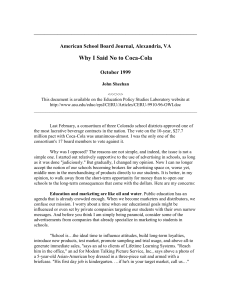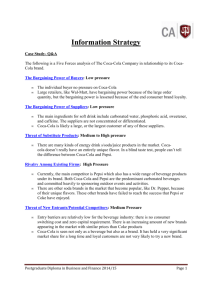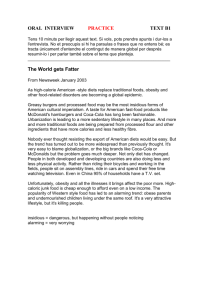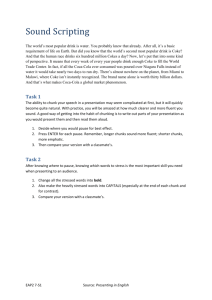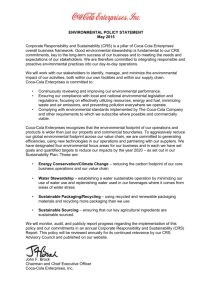Advertisements R Us - WW Norton & Company
advertisement
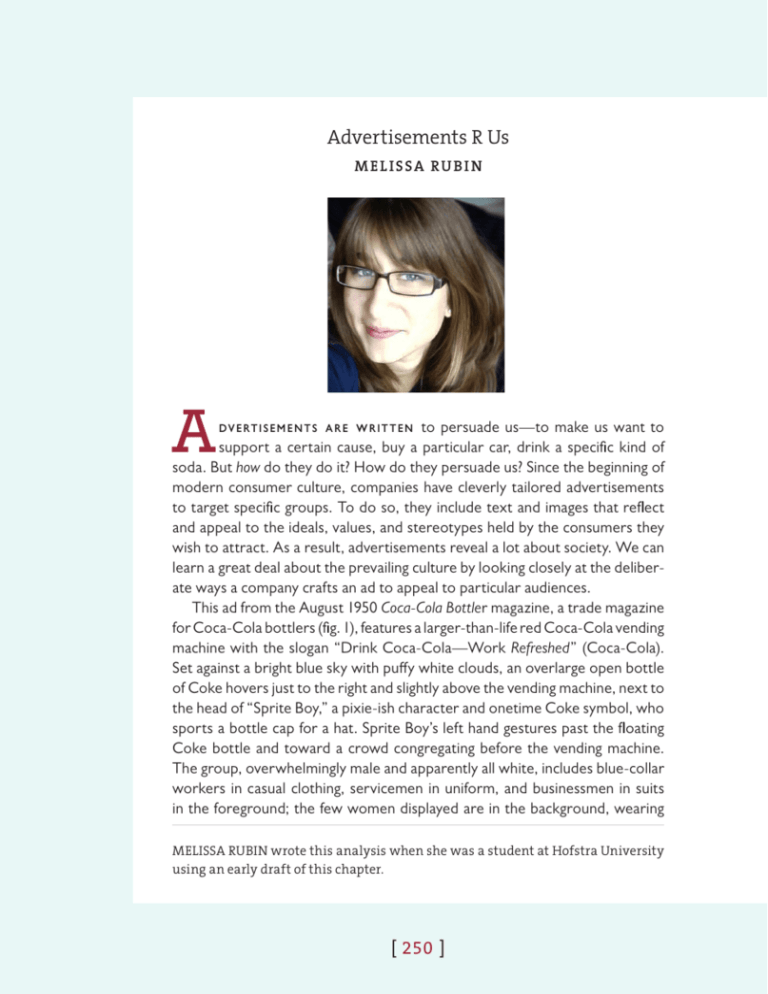
Advertisements R Us M EL ISSA RU BI N A dvertisements are written to persuade us—to make us want to support a certain cause, buy a particular car, drink a specific kind of soda. But how do they do it? How do they persuade us? Since the beginning of modern consumer culture, companies have cleverly tailored advertisements to target specific groups. To do so, they include text and images that reflect and appeal to the ideals, values, and stereotypes held by the consumers they wish to attract. As a result, advertisements reveal a lot about society. We can learn a great deal about the prevailing culture by looking closely at the deliberate ways a company crafts an ad to appeal to particular audiences. This ad from the August 1950 Coca-Cola Bottler magazine, a trade magazine for Coca-Cola bottlers (fig. 1), features a larger-than-life red Coca-Cola vending machine with the slogan “Drink Coca-Cola—Work Refreshed” (­Coca-Cola). Set against a bright blue sky with puffy white clouds, an overlarge open bottle of Coke hovers just to the right and slightly above the vending machine, next to the head of “Sprite Boy,” a pixie-ish character and onetime Coke symbol, who sports a bottle cap for a hat. Sprite Boy’s left hand gestures past the floating Coke bottle and toward a crowd congregating before the vending machine. The group, overwhelmingly male and apparently all white, includes blue-collar workers in casual clothing, servicemen in uniform, and businessmen in suits in the foreground; the few women displayed are in the background, wearing MELISSA RUBIN wrote this analysis when she was a student at Hofstra University using an early draft of this chapter. [ 250 ] Rubin / Advertisements R Us Fig. 1. 1950 ad from Coca-Cola Bottler magazine (Coca-Cola). [ 251 ] [ 252 ] GEN R ES OF W R I T ING dresses. The setting is industrialized and urban, as indicated by the factory and smokestacks on the far left side of the scene and by the skyscrapers and apartment building on the right. Practically since its invention, Coca-Cola has been identified with mainstream America. Born from curiosity and experimentation in an Atlanta pharmacy in 1886, Coke’s phenomenal growth paralleled America’s in the industrial age. Benefiting from developments in technology and transportation, by 1895 it was “sold and consumed in every state and territory in the United States” (Coca-Cola Company). In 2010, Diet Coke became the second-mostpopular carbonated drink in the world . . . behind Coca-Cola (Esterl). In the immediate post-war world, Coke became identified with American optimism and energy, thanks in part to the company’s wartime declaration that “every man in uniform gets a bottle of Coca-Cola for 5 cents, wherever he is, and whatever it costs the Company” (Coca-Cola Company). To meet this dictate, bottling plants were built overseas with the result that many people other than Americans first tasted Coke during this war that America won so decisively, and when peace finally came, “the foundations were laid for Coca-Cola to do business overseas” (Coca-Cola Company). Given the context, just a few years after World War II and at the beginning of the Korean War, the setting clearly reflects the idea that Americans experienced increased industrialization and urbanization as a result of World War II. Factories had sprung up across the country to aid in the war effort, and many rural and small-town Americans had moved to industrial areas and large cities in search of work. In this advertisement, the buildings surround the people, symbolizing a sense of community and the way Americans had come together in a successful effort to win the war. The ad suggests that Coca-Cola recognized the patriotism inspired by the war and wanted to inspire similar positive feelings about their product. In the center of the ad, the huge red vending machine looks like the biggest skyscraper of all—the dominant feature of the urban industrial landscape. On the upper right, the floating face of Coca-Cola’s Sprite Boy towers above the scene. A pale character with wild white hair, hypnotic eyes, and a mysterious smile, Sprite Boy stares straight at readers, his left hand gesturing toward the red machine. Sprite Boy’s size and placement in the ad makes him appear godlike, as if he, the embodiment of Coca-Cola, is a powerful force uniting—and refreshing—hardworking Americans. The placement of the vending machine in the center of the ad and the wording on it evoke the idea that drinking Coca-Cola will make a hardworking American feel refreshed while he (and 5 Rubin / Advertisements R Us apparently it was rarely she) works and becomes part of a larger community. The text at the bottom of the ad, “A welcome host to workers—Inviting you to the pause that refreshes with ice-cold Coca-Cola”—sends the same message to consumers: Coke will refresh and unite working America. The way that Coca-Cola chooses to place the objects and depict men and women in this ad speaks volumes about American society in the middle of the twentieth century: a white, male-dominated society in which servicemen and veterans were a numerous and prominent presence. The clothing that the men in the foreground wear reflects the assumption that the target demographic for the ad—people who worked in Coca-Cola bottling plants—valued hard workers and servicemen during a time of war. White, uniformed men are placed front and center. One man wears an Army uniform, the one next to him wears a Navy uniform, and the next an Air Force uniform. By placing the servicemen so prominently, Coca-Cola emphasizes their important role in society and underscores the value Americans placed on their veterans at a time when almost all male Americans were subject to the draft and most of them could expect to serve in the military or had already done so. The other men in the foreground—one wearing a blue-collar work uniform and the other formal business attire—are placed on either side of and slightly apart from the soldiers, suggesting that civilian workers played a valuable role in society, but one secondary to that of the military. Placing only a few women dressed in casual day wear in the far background of the image represents the assumption that women played a less important role in society—or at least in the war effort and the workforce, including Coke’s. The conspicuous mixture of stereotypical middle-class and working-class attire is noteworthy because in 1950, the U.S. economy had been marked by years of conflict over labor’s unionization efforts and management’s opposition to them—often culminating in accommodation between the two sides. The ad seems to suggest that such conflict should be seen as a thing of the past, that men with blue-collar jobs and their bosses are all “workers” whom Coca-Cola, a generous “host,” is inviting to share in a break for refreshments. Thus all economic classes, together with a strong military, can unite to build a productive industrial future and a pleasant lifestyle for themselves. From the perspective of the twenty-first century, this ad is especially interesting because it seems to be looking backward instead of forward in significant ways. By 1950, the highly urban view of American society it presents was starting to be challenged by widespread movement out of central cities to the suburbs, but nothing in the ad hints at this profound change. At the time, [ 253 ] [ 254 ] GEN R ES OF W R I T ING offices and factories were still located mostly in urban areas and associated in Americans’ minds with cities, and the ad clearly reflects this perspective. In addition, it presents smoke pouring from factory smokestacks in a positive light, with no sign of the environmental damage that such emissions cause, and that would become increasingly clear over the next few decades. Another important factor to consider: everyone in the ad is white. During the 1950s, there was still a great deal of racial prejudice and segregation in the United States. Coca-Cola was attuned to white society’s racial intolerance and chose in this ad to depict what they undoubtedly saw as average Americans, the primary demographic of the audience for this publication: Coca-Cola employees. While Coke did feature African Americans in some ads during the late 1940s and early 1950s, they were celebrity musicians like Louis Armstrong, Duke Ellington, Count Basie, or Graham Jackson (the accordion player who was a huge favorite of Franklin Delano Roosevelt’s) or star athletes like Marion Motley and Bill Willis, the first men to break the color barrier in NFL football (“World of Coca-Cola”). The contrast between these extremes underscores the prejudice: “ordinary” people are represented by whites, while only exceptional African Americans appear in the company’s ads. In 1950, then, the kind of diversity that Coke wanted to highlight and appeal to was economic (middle-class and working-class) and war-related (civilian and military). Today, such an ad would probably represent the ethnic diversity missing from the 1950 version, with smiling young people of diverse skin colors and facial features relaxing with Cokes, probably now in cans rather than bottles. But the differences in economic, employment, or military status or in clothing styles that the 1950 ad highlighted would be unlikely to appear, not because they no longer exist, but because advertisers for products popular with a broad spectrum of society no longer consider them a useful way to appeal to consumers. While initially the ads for Coca-Cola reflected the values of the time, their enormous success eventually meant that Coke ads helped shape the American identity. In them, Americans always appear smiling, relaxed, carefree, united in their quest for well-deserved relaxation and refreshment. They drive convertibles, play sports, dance, and obviously enjoy life. The message: theirs is a life to be envied and emulated, so drink Coca-Cola and live that life yourself. 10 Rubin / Advertisements R Us Works Cited Coca-Cola. Advertisement. The Coca-Cola Bottler 41.6 (1950): n. pag. Web. 5 May 2011. Coca-Cola Company. “The Coca-Cola Company Heritage Timeline.” CocaCola History. Coca-Cola Company, n.d. Web. 26 June 2011. Esterl, Mike. “Diet Coke Wins Battle in Cola Wars.” Wall Street Journal. 17 Mar. 2011: B1. Print. “The World of Coca-Cola Self-Guided Tour for Teachers. Highlights: AfricanAmerican History Month.” World of Coca-Cola. World of Coca-Cola at Pemberton Place, n.d. Web. 26 June 2011. Thinking about the Text 1. What insight does Melissa Rubin offer about the Coca-Cola ad she analyzes, and what evidence does she provide to support her analysis? Has she persuaded you to accept her conclusions? Why or why not? 2. What historical context does Rubin provide, and what does that information contribute to her analysis? 3. Rubin’s analysis is driven by this question: what can we learn about the culture in which a given ad is created by closely examining how that ad appeals to particular audiences? What other questions might you try to answer by analyzing an ad? 4. Rubin looks closely at the men and women shown in this ad and makes certain assumptions about them. What sorts of details does she point out to identify who these people are? Do you think she’s represented them accurately? If not, how might you identify them differently, and why? 5. Write an analysis of a current ad, looking specifically at how it reflects American values in the twenty-first century. Be sure to include the ad in your essay. [ 255 ]


